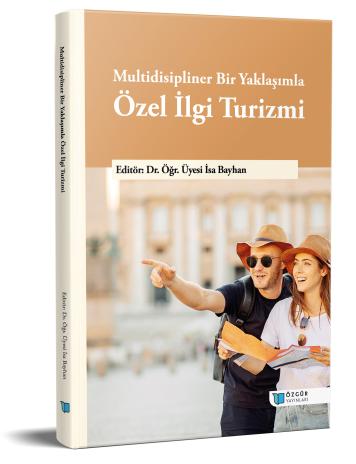
Special Interest Tourism: A Multidisciplinary Approach
Synopsis
Tourism has evolved into a multidimensional structure that extends beyond its traditional purposes, now addressing the diverse interests of individuals. This book, titled “Special Interest Tourism: A Multidisciplinary Approach”, offers a comprehensive and multifaceted perspective on one of the most dynamic and rapidly developing tourism areas—special interest tourism. Shaped by individuals' interests, passions, cultural pursuits, value systems, and lifestyles, special interest tourism intersects with various thematic fields such as nature, culture, art, history, archaeology, faith, gastronomy, and sports.
With contributions from various academic disciplines, this book aims to provide a thorough examination of special interest tourism, both in theoretical and practical contexts, thereby making a substantial contribution to the field. Accordingly, the chapters in this book are organized under categories based on nature, culture, sports, and lifestyle-oriented themes, as outlined below.:
- The first chapter, titled “A General Overview of the Conceptual Framework, Types, Impacts, Sectoral Reflections, and Future Perspectives of Special Interest Tourism”, addresses the definition of special interest tourism, its primary types, impacts, distinctions from other tourism forms, and its sectoral implications, while also offering insights into its future outlook.
- The second chapter, “Specialization in Nature Tour Guiding within the Scope of Special Interest Tourism”, emphasizes nature tourism, nature-based routes, and the critical role of guides in the planning and management of nature tours, discussing the importance of specialization in this field.
- The third chapter, “A Comparative Analysis of Botanical Gardens within the Scope of Educational, Research, and Digitalization Initiatives: Examples from the UNESCO World Heritage List and BGCI”, presents a comparative evaluation of botanical gardens through examples from UNESCO and BGCI, focusing on their roles in education, research, and digital innovation.
- The fourth chapter, “Cittaslow Movement in The Axis of Globalization: The Example of Köyceğiz”, examines the Cittaslow movement through the case of Köyceğiz, exploring the balance between globalization and the preservation of local values.
- The fifth chapter, “Religious Tourism: A Conceptual Overview”, provides a conceptual framework for faith-based travel, illustrating its significance and applications within the broader field of tourism.
- The sixth chapter, “The Contribution of Archaeological Excavations to Tourism Value: The Case of Konuralp Prusias ad Hypium”, investigates the potential of archaeological and cultural heritage sites as tourist attractions.
- The seventh chapter, “Museum Experience Shaped within the Framework of Nighttime Museology Practices”, explores night-time museum experiences as an innovative approach that diversifies visitor engagement and enhances cultural transmission.
- The eighth chapter, “Gastronomy Tourism in Turkey and Worldwide”, outlines the conceptual background of gastronomy tourism and discusses its development and contributions to destinations both in Turkey and across the globe.
- The ninth chapter, “Evaluation of Sports Aviation Activities within the Scope of Special Interest Tourism”, analyzes the scope, types, key destinations, and various aspects of air sports, situating them within the broader context of special interest tourism.
- The tenth chapter, “Capturing A Different Dimension in Romance Tourism Within The Scope of Alternative Tourism: Sunrise-Sunset Tourism”, presents an innovative perspective on the transformation of sunrise and sunset moments into tourism products within the field of romantic tourism.
- The eleventh chapter, “An Evaluation of Ethics-Based Competitive Strategies within the Framework of Digitalization and Sustainability in Halal Tourism from a Corporate Quality Perspective”, discusses halal tourism through the lenses of digitalization, sustainability, and ethical competition, while emphasizing institutional quality approaches.
Through the chapters outlined above, this book provides interdisciplinary insights into various subtypes of special interest tourism, offering both academic knowledge and sector-oriented guidance. Each chapter benefits from contributions by subject-matter experts, enriching the content with practical implications derived from theoretical frameworks. As a result, readers will gain a holistic understanding of the potential, scope, social, economic, and cultural impacts, current practices, and future prospects of diverse forms of special interest tourism. Thus, Special Interest Tourism: A Multidisciplinary Approach serves as an informative and inspiring reference for tourism planners, industry professionals, researchers, academics, tourists, and students interested in this field.

